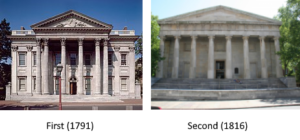Early in the history of the United States, bank regulations were created for the existence of a national central bank.
This was actually tried twice, and both times, for political reasons, the banks were shut down.
Alexander Hamilton because the first Secretary of the Treasury of the United States, in 1790. Being a proponent of a strong central bank, he recommend a national bank be created that would be the “Bank of the United States”, modelled on the Bank of England. He wanted it to be a private bank.
Congress approved his recommendation and chartered this bank in 1791. While this bank was new in the United States, banking was not. A number of banks were created after the War of Independence ended.
————————————
This post is part of a larger series and sub-series.
Here is a link to the series: The history of banks and banking regulation
and to the sub-series: United States Banking and Bank Regulation History
————————————
The United States had no national currency, and banks issued their own. These notes circulated in the various states, and their value fluctuated from bank to bank and time to time. Sometimes rather significantly.
The situation was so bad that in 1799 John Adams was quoted as saying:
“the fluctuations of our circulating medium have committed greater depredations upon the property of honest men than all the French piracies.”
https://en.wikisource.org/wiki/A_History_of_Banking_in_the_United_States/Chapter_3
The individual states started efforts at bank regulation.
In 1799 Massachusetts and New Hampshire prohibited unincorporated banks. New York did the same in 1804. These rules were modelled on the English Bubble Act of 1720, whose purpose was to curb speculation, by requiring businesses to obtain government approval (a charter) before they could sell stock to the public or issue banknotes.
Even with competition, the Bank of the United States became a dominant bank, with branches in Boston, New York, Washington, Norfolk, Charleston, Savannah, and New Orleans.
The Bank of the United States was becoming a threat to state banks that competed with it and were appearing more and more, such that Congress did not renew its charter in 1811, after which it ceased to exist.
However, difficulties that occurred during the War of 1812 resulted in a new Bank of the United States being chartered in 1816.
The states did not appreciate this. Fourteen states passed laws prohibiting this second Bank of the United States from collecting its debts. Six states tried to tax the branches of this second Bank of the United States that were in other states. This was however stopped by the Supreme Court decision McCulloch v. Maryland, a ruling that freed the bank from restrictive state regulations.
In 1819, a financial panic was blamed on the conservative lending practices of the Bank of the United States. That the bank foreclosed on large amounts of real estate after the panic did not help the states feel better about its existence.
The appointment of a new bank president, Nicholas Biddle, in 1823 helped, as he was well respected and implemented policies that helped stabilize the finance system.
Biddle pursued aggressive expansion and by 1830 the bank had twenty-five branches and was making profits of more than $3 million a year. It was conducting 20% of all banking business in the United States at that time.
The bank became the center of a political battle between Andrew Jackson, who wanted to shut it down, and Henry Clay, who used the issue of the bank to further his Presidential ambitions.
As Clay’s party had control of both houses of Congress, he was able to influence the recharting of the bank in 1832.
President Jackson vetoed the bill, the veto was upheld, and the charter expired.
Jackson then ordered the government’s deposits to be moved to state banks that were politically aligned with him.
The politicking continued, with Clay leading the effort for Jackson to be censured by the Senate for his order to move the government’s money (I wasn’t even aware the Senate could censure the President – I thought they could only censure other Senators), but in 1837 the Senate voted to reverse that censure.
However, in 1836 the charter for the Bank of the United States was once again not renewed, and once again, it ceased to exist.
This political struggle over the Bank of the United States halted any effort to create a central banking authority for about 80 years.



